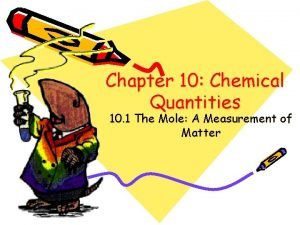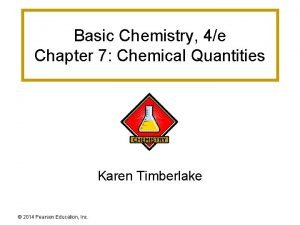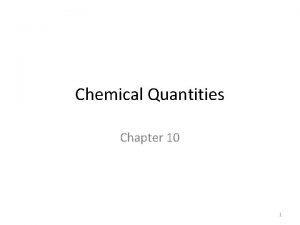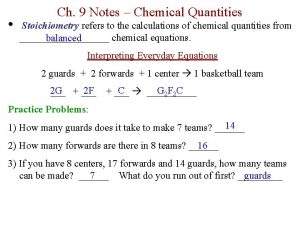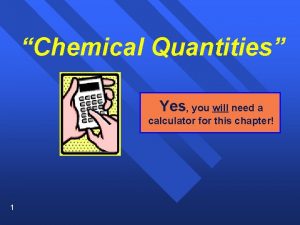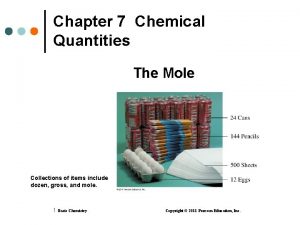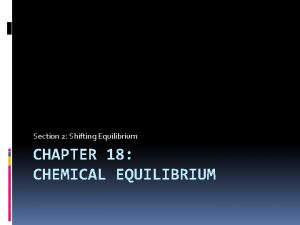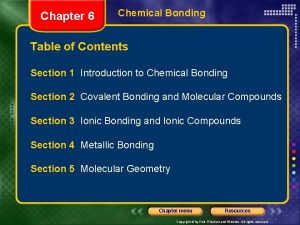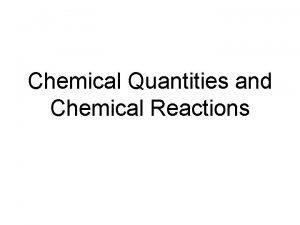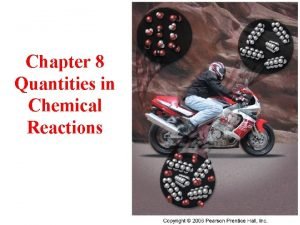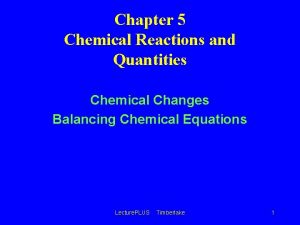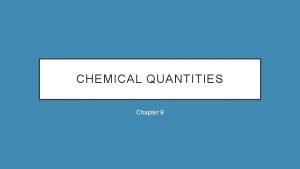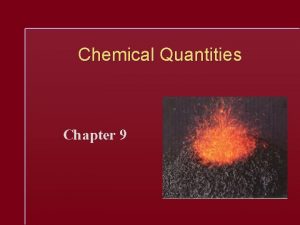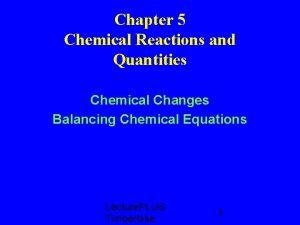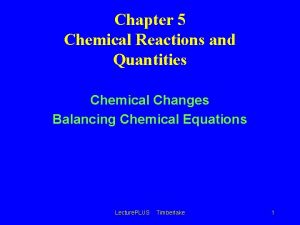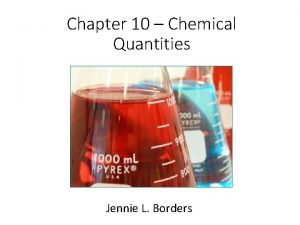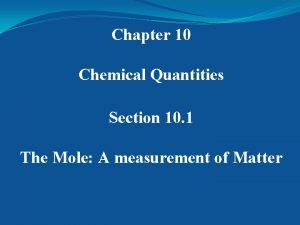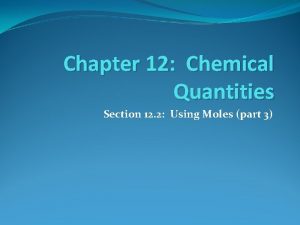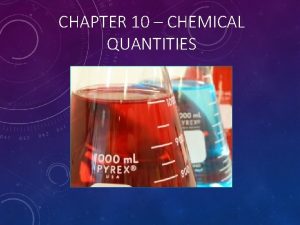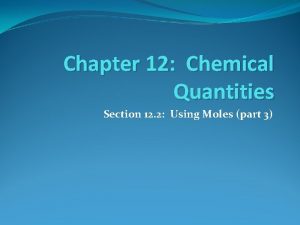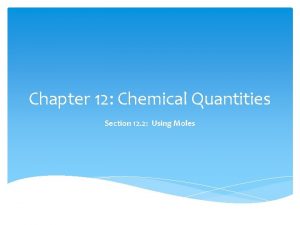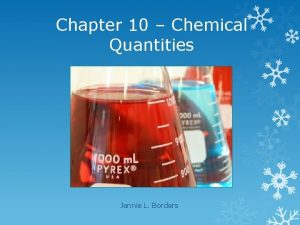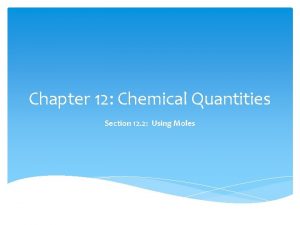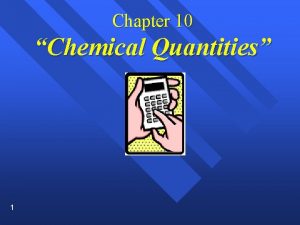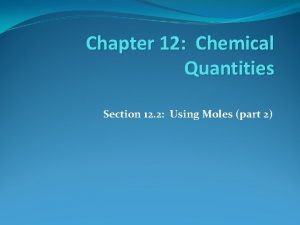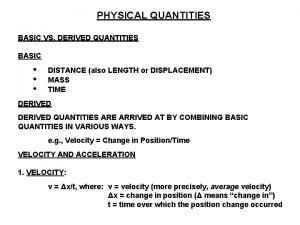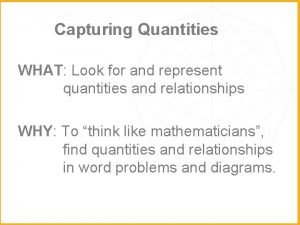Chapter 7 Chemical Quantities Section 7 1 The













































- Slides: 45

Chapter 7 – Chemical Quantities


Section 7. 1 The Mole: A Measurement of Matter Objectives: ◦ Describe how Avogadro’s number is related to a mole of any substance ◦ Calculate the mass of a mole of any substance

Representative Particles Types of representative particles: ◦ Atoms (Single element) ◦ Molecules (Covalent/Molecular Compound) ◦ Formula Units (Ionic Compound) ◦ Ions (+/- charge)

Representative Particles Compou nd Ionic Molecular (metal, nonmetal) (nonmetals) Charge (+/-) Element (one capital letter, no subscript) Ion Atom Formula Unit Molecule

Ex. Label each representative particle. KF formula unit CO 2 molecule He atom Ba(OH)2 formula unit F 2 molecule H 2 O molecule SO 42 - H 3 O + ion

What Is a Mole? Mole (mol) – a quantity which represents 6. 02 x 1023 representative particles of any given substance. ◦ Avogadro’s Number – 6. 02 x 1023 or 1 mole ◦ The term “mol” is similar to: dozen, ream, bushel ◦ Representative particle – the species present in a substance: atoms, molecules, formula units, ions.

How large is a mol? A mol of golf balls: ◦ lined up would go to the sun and back ~1 billion times (dist to sun is ~92, 000 miles) A mol of animal moles: ◦ spread over the Earth would make a layer 8 million animal moles thick

Conversion Factors 1 mole = 6. 02 x 1023 atoms 1 mole = 6. 02 x 1023 molecules 1 mole = 6. 02 x 1023 formula units 1 mole = 6. 02 x 1023 ions

Ex: How many atoms are there in 1. 14 mol Ag? 1. 14 mole Ag x 6. 02 x 1023 atoms = 6. 8628 x 1023 atoms Ag 1 mole Ag 6. 86 x 1023 atoms Ag

Ex: How many moles of magnesium is 1. 25 x 1023 atoms of magnesium? 23 1. 25 x 10 atom Mg x 1 mole Mg = 0. 207641196 mol Mg 6. 02 x 1023 atoms Mg 0. 208 moles Mg

Ex: How many molecules is 0. 360 mol of water? 0. 360 mole H 2 O x 6. 02 x 1023 molecules = 2. 1672 x 1023 molecules H 2 O 1 mole H 2 O 2. 17 x 1023 molecules H 2 O

Ex: How many moles of NO 2 are there in 4. 65 x 1024 molecules of NO 2? 4. 65 x 1024 molecules NO 2 x 1 mole NO 2 = 7. 724 mol NO 2 6. 02 x 10 23 molecules NO 2 7. 72 moles NO 2

Caution! Be careful when being asked to convert moles of a compound into atoms! ◦ We will need to multiply the final answer by the number of atoms in the compound. MOLE CROSSING

Ex: How many atoms are there in 1. 14 mol SO 3? 1. 14 mol x 6. 02 x 1023 molecules x 4 atoms = 2. 74512 x 1024 atoms 1 molecule 2. 75 x 1024 atoms

Ex: How many atoms are in 2. 12 mol of propane (C 3 H 8)? 2. 12 mol x 6. 02 x 1023 molecules x 11 atoms = 1. 403864 x 1025 atoms 1 molecule 1. 40 x 1025 atoms

The Mass of a Mole of an Element The gram atomic mass (gam) is the atomic mass of an element expressed in grams. We will use the periodic table to determine this. ◦ Gram atomic mass of Carbon = 12. 01 g ◦ Gram atomic mass of Nitrogen = 14. 01 g ◦ Gram atomic mass of Sulfur = 32. 06 g The gram atomic mass is equivalent to one mole of the atom. Use the Periodic Table

The Mass of a Mole of a Compound The gram molecular mass (gmm) of any molecular compound is the mass of 1 mole of that compound. We will again use the periodic table to determine this. Find the gram molecular mass of the following: ◦ H 2 O 2 ◦ N 2 O 5 ◦ Ca(OH)2

The Mass of a Mole of a Compound The mass of one mole of an ionic compound is the gram formula mass (gfm). A gram formula mass is calculated the same way as a gram molecular mass. Find the gram formula mass of the following: ◦ Ca. I 2 ◦ (NH 4)2 CO 3

Section 7. 1 The Mole: A Measurement of Matter Did We Meet Our Objectives? ◦ Describe how Avogadro’s number is related to a mole of any substance ◦ Calculate the mass of a mole of any substance Charlotte would be proud!

Section 7. 2 Mole-Mass and Mole. Volume Relationships Objectives: ◦ Use the molar mass to convert between mass and moles of a substance ◦ Use the mole to convert among measurements of mass, volume, and number of particles

The Mass of a Mole of an Element Molar mass – mass of 1 mol of any substance. Can be used in calculations involving elements, molecular compounds, and ionic compounds ◦ 1. 0 mol of C has a mass of 12. 01 g/mol ◦ 1. 0 mol of H 2 has a mass of 2. 02 g/mol ◦ 1. 0 mol H 2 O has a mass of 18. 02 g/mol

Ex: Find the mass, in grams, of 2. 5 mols of Na. 2. 5 mol Na x 22. 99 g Na = 57. 475 g Na 1 mole Na 57 g Na

Ex: Find the number of mols in 75. 0 g of dinitrogen trioxide (N 2 O 3). 75. 0 g N 2 O 3 x 1 mol N 2 O 3 = 0. 98658 mol N 2 O 3 76. 02 g N 2 O 3 0. 987 mol N 2 O 3

Ex: Find the mass, in grams, of 3. 0 mols of molecular oxygen, O 2. 3. 0 mol O 2 x 32. 00 g O 2 = 96 g O 2 1 mol O 2 96 g O 2

Ex: Find the number of moles in 236. 5 g of Cu. SO 4. 236. 5 g Cu. SO 4 x 1 mol Cu. SO 4 = 1. 4817 mol Cu. SO 4 159. 61 g Cu. SO 4 1. 482 mol Cu. SO 4

Volume of a Mole of Gas Standard temperature and pressure (STP) – conditions in which gas volumes are generally measured ◦ Standard Temperature: 0 o. C, 273 K, or 32 o. F ◦ Standard Pressure: 101. 3 k. Pa, 1 atm, 760 mm Hg Molar volume – 1 mol of any gas at STP takes up 22. 4 L of space.

Ex: What is the volume of 0. 960 mol of CH 4 at STP? 0. 960 mol CH 4 x 22. 4 L CH 4 = 21. 504 L CH 4 1 mol CH 4 21. 5 L CH 4

Ex: What is the volume of 1. 5 mol of N 2 at STP? 1. 5 mol N 2 x 22. 4 L N 2 = 33. 6 L N 2 1 mol N 2 34 L N 2

Ex: How many mols are in 2. 50 L of CO 2 at STP? 2. 50 L CO 2 x 1 mol CO 2 = 0. 111607 mol CO 2 22. 4 L CO 2 0. 112 mol CO 2

Ex: What is the molar mass of a gas with a density of 1. 964 g/L at STP? 1. 964 g x 22. 4 L = 43. 9936 g/mol L 1 mol 43. 99 g/mol

The Mole Road Map

Ex: Calculate the number of molecules in 60. 0 g NO 2 x 1 mol NO 2 x 6. 02 x 1023 molecules NO 2 46. 01 g NO 2 1 mol NO 2 7. 85046729 x 1023 molecules 7. 85 x 1023 molecules

Ex: Calculate the volume, in liters, of 3. 24 x 1022 molecules Cl 2 at STP. 3. 24 x 1022 molecules Cl 2 x 1 mol x 22. 4 L 6. 02 x 10 23 molecules 1 mol 1. 21 L Cl 2 at STP

Section 7. 2 Mole-Mass and Mole. Volume Relationships Did We Meet Our Objectives? ◦ Use the molar mass to convert between mass and moles of a substance ◦ Use the mole to convert among measurements of mass, volume, and number of particles

Section 7. 3 Percent Composition and Chemical Formulas Objectives: ◦ Calculate the percent composition of a substance from its chemical formula or experimental data ◦ Derive the empirical formula and molecular formula of a compound from experimental data

Calculating the Percent Composition of a Compound Percent composition – the relative amounts of each element in a compound ◦ Percent by Mass

Ex: An 8. 20 g piece of magnesium combines completely with 5. 40 g of oxygen to form a compound. What is the percent composition of this compound?

Calculating the Percent Composition of a Compound Percent composition – the relative amounts of each element in a compound ◦ Percent by Composition

Ex: Find the percent composition of propane (C 3 H 8).

Using Percent as a Conversion Factor To do this, you multiply the mass of the compound by a conversion factor that is based on the percent composition. ◦ Ex: Calculate the mass of carbon in 82. 0 g of propane (C 3 H 8). (Remember, carbon is 81. 8%)

Calculating Empirical Formulas Empirical formula – gives the lowest whole number ratio of atoms of the elements in a compound ◦ Empirical formula can sometimes be the molecular formula CO 2 C 6 H 12 O 6 CH 2 O

Calculating Empirical Formulas The polymer used for the nonstick surface of cooking utensils is 24. 0% C and 76. 0% F by mass. ◦ What is the empirical formula of this polymer?

Calculating Molecular Formulas The polymer used for the nonstick surface of cooking utensils is 24. 0% C and 76. 0% F by mass. ◦ What is the empirical formula of this polymer? ◦ If the molecular mass is 100. 02 g, what is the molecular formula?

Section 7. 3 Percent Composition and Chemical Formulas Did We Meet Our Objectives? ◦ Calculate the percent composition of a substance from its chemical formula or experimental data ◦ Derive the empirical formula and molecular formula of a compound from experimental data
 Angular acceleration vs linear acceleration
Angular acceleration vs linear acceleration Chapter 7 chemical quantities answer key
Chapter 7 chemical quantities answer key Chemistry chapter 10 chemical quantities
Chemistry chapter 10 chemical quantities Chapter 7 chemical quantities answer key
Chapter 7 chemical quantities answer key Chapter 10 chemical quantities
Chapter 10 chemical quantities Chapter 10 chemical quantities practice problems answer key
Chapter 10 chemical quantities practice problems answer key Chapter 9 chemical quantities
Chapter 9 chemical quantities Section 2 classifying chemical reactions worksheet answers
Section 2 classifying chemical reactions worksheet answers Section 2 classifying chemical reactions worksheet answers
Section 2 classifying chemical reactions worksheet answers Section 1 chemical changes
Section 1 chemical changes The calculations of quantities in chemical reactions
The calculations of quantities in chemical reactions The calculation of quantities in chemical equations
The calculation of quantities in chemical equations Chemical quantities calculator
Chemical quantities calculator Unit chemical quantities the mole 1 step
Unit chemical quantities the mole 1 step Chapter 7 chemical formulas and chemical compounds test
Chapter 7 chemical formulas and chemical compounds test Chemical formulas and chemical compounds chapter 7 review
Chemical formulas and chemical compounds chapter 7 review Chapter 18 chemical reactions balancing chemical equations
Chapter 18 chemical reactions balancing chemical equations Chapter 18 review chemical equilibrium
Chapter 18 review chemical equilibrium Reaction rates and equilibrium worksheet answers chapter 19
Reaction rates and equilibrium worksheet answers chapter 19 Chapter 8 review describing chemical reactions
Chapter 8 review describing chemical reactions Chapter 8 section 1 chemical equations and reactions
Chapter 8 section 1 chemical equations and reactions Chapter 6 chemical bonding section 4
Chapter 6 chemical bonding section 4 Physical quantity table unit of measure
Physical quantity table unit of measure Chapter 10 section 1 meiosis
Chapter 10 section 1 meiosis Hát kết hợp bộ gõ cơ thể
Hát kết hợp bộ gõ cơ thể Lp html
Lp html Bổ thể
Bổ thể Tỉ lệ cơ thể trẻ em
Tỉ lệ cơ thể trẻ em Chó sói
Chó sói Chụp phim tư thế worms-breton
Chụp phim tư thế worms-breton Chúa sống lại
Chúa sống lại Các môn thể thao bắt đầu bằng tiếng bóng
Các môn thể thao bắt đầu bằng tiếng bóng Thế nào là hệ số cao nhất
Thế nào là hệ số cao nhất Các châu lục và đại dương trên thế giới
Các châu lục và đại dương trên thế giới Công thức tính thế năng
Công thức tính thế năng Trời xanh đây là của chúng ta thể thơ
Trời xanh đây là của chúng ta thể thơ Mật thư anh em như thể tay chân
Mật thư anh em như thể tay chân Phép trừ bù
Phép trừ bù độ dài liên kết
độ dài liên kết Các châu lục và đại dương trên thế giới
Các châu lục và đại dương trên thế giới Thể thơ truyền thống
Thể thơ truyền thống Quá trình desamine hóa có thể tạo ra
Quá trình desamine hóa có thể tạo ra Một số thể thơ truyền thống
Một số thể thơ truyền thống Cái miệng nó xinh thế chỉ nói điều hay thôi
Cái miệng nó xinh thế chỉ nói điều hay thôi Vẽ hình chiếu vuông góc của vật thể sau
Vẽ hình chiếu vuông góc của vật thể sau Thế nào là sự mỏi cơ
Thế nào là sự mỏi cơ


